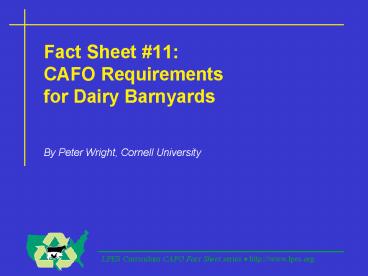Fact Sheet - PowerPoint PPT Presentation
1 / 27
Title: Fact Sheet
1
Fact Sheet 11CAFO Requirementsfor Dairy
Barnyards
- By Peter Wright, Cornell University
2
CAFO Rules
- Dairy farms with 200 or more cows
- OR with 300 or more heifers
- MAY need an NPDES.
- See CAFO Fact Sheet 2 Do I Need an NPDES
Permit for My Livestock or Poultry Operation?
3
Production Areas
- Includes the animal confinement areas (barnyard),
the manure storage area, the raw material storage
area, and the waste containment area - No discharge of manure or process wastewater
4
(No Transcript)
5
(No Transcript)
6
(No Transcript)
7
No Discharge
- Unless rainfall exceeds a 25-year, 24-hour storm
AND the barnyard is designed to handle the
stormAND the CAFO criteria are met - Inspection
- Monitoring
- Record keeping
- Mortality disposal
8
25-Year, 24-Hour Rainfall
9
Pasture or Barnyard?
- Pasture
- Not regulated
- Vegetation
- Includes laneways used to move animals to and
from the pasture
- Barnyard
- Regulated
- Bare spots
- Includes areas the animals congregate in
10
(No Transcript)
11
(No Transcript)
12
Can the Barnyard be
- Eliminated?
- Reduced?
- Moved?
13
Barnyard Sizes, Ft2
From Beef Housing and Equipment Handbook.
14
Keep the Clean Water Clean
- Divert surface water
- Diversions
- Land grading
- Roof water
- Drip trench
- Roof gutters
15
(No Transcript)
16
(No Transcript)
17
Catch the Runoff
- Shape the barnyard.
- Use curbs.
- Use storage ponds.
18
(No Transcript)
19
Treat the Runoff
- Applied agronomically
- See CAFO Fact Sheet 20 What is Required in a
Nutrient Management Plan? - Vegetated filter area
- Constructed wetland
20
Where to Go for Help
- Agricultural engineers
- Natural Resources Conservation Service (NRCS)
- Soil and Water Conservation Districts (SWCD)
- Cooperative Extension
21
Is Cost Sharing Available?
- USDA-NRCS EQIP funds
- See CAFO Fact Sheet 40 Financial and Technical
Assistance Available to CAFO Owners/Operators. - State cost sharing?
- Environmental organizations?
22
Author
Peter Wright, a Manure Management Specialist,
PRO-DAIRY at Cornell University, can be reached
at pew2_at_cornell.edu.
23
Reviewers
- The author wishes to thank Dana Chapman,
Agricultural Consulting Service Lee Telega,
PRO-DAIRY and Alyssa Dodd , Penn State
University, for their review of this fact sheet.
24
For More Information
Environmental Regulations Related ResourcesEPA
CAFO Phone Line202-564-0766 http//www.epa.gov/np
des/caforule/To obtain copy of
regulations http//www.epa.gov/npdes/afo/statecont
acts/To obtain state environmental agency
contacts http//www.epa.gov/agriculture/animals.ht
ml/To obtain compliance assistance information
from EPA http//cfpub.epa.gov/npdes/contacts.cfm?p
rogram_id7typeREGION/To obtain EPA Region
Animal Feeding Operation contacts
25
For More Information (cont'd)
- Land-Grant University Resources
- The local contact for your land-grant university
Cooperative Extension program is listed in the
phone book under "Cooperative Extension" or
"(county name) County Cooperative Extension." - http//www.reeusda.gov/1700/statepartners/usa.htm/
To obtain state Cooperative Extension contacts - http//www.lpes/To view the Livestock and
Poultry Environ-mental Stewardship (LPES)
curriculum resources
26
For More Information (cont'd)
- USDA Farm Bill Resources
- To obtain more information about the Farm Bill
2002, see the USDA-NRCS website at the following
URL http//www.nrcs.usda.gov/programs/farmbill/20
02/. - You can also contact your local USDA Service
Center, listed in the phone book under "U.S.
Department of Agriculture," or your local
conservation district.
27
Funding
- This material is based upon work supported by
the Cooperative State Research, Education, and
Extension Service, U.S. Department of
Agriculture the U.S. Environmental Protection
Agency, the National Agriculture Assistance
Center and the University of Nebraska
Cooperative Extension, University of
Nebraska-Lincoln, under Cooperative Agreement
Number 97-EXCA-3-0642.































